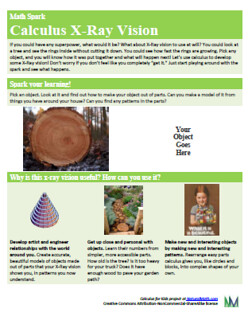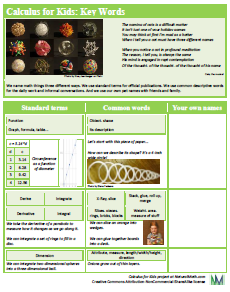Calculus for Kids April 10, 2015 (Fridays)
This is a photo gallery for a math circle called Calculus for Kids, in Cary, NC. Math circles are informal groups where children, their families, and teachers explore math together. This session was our first introduction to making shapes out of shapes. Here are two pieces of supporting materials for the topic:
One-page Math Spark for building models.
One-page sheet with relevant terms
Calculus for Math Circle begins!

Ice breaking time: Who are you? If you’re happy and you know it raise your hand… We take turns naming one thing we love, and whoever else loves it too – waves.

Bonk on the head to show whose turn it is to introduce themselves.
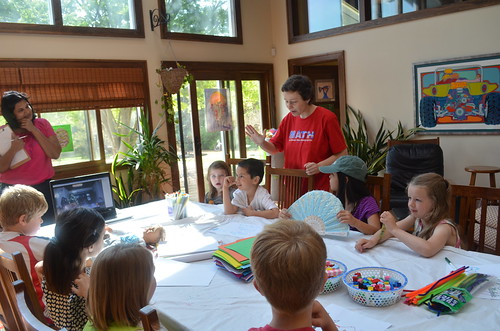
If Maria bonks everybody on the head, who bonks Maria on the head? All together now…
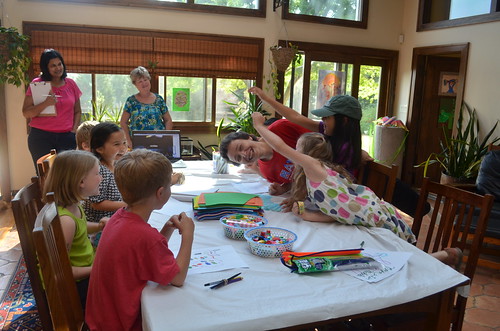
Julianne loves to draw.

Maya wants to make a 2-dimensional fan!
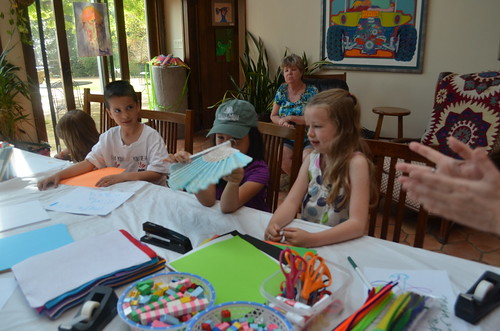
I want to make a pine cone in 3D shape!
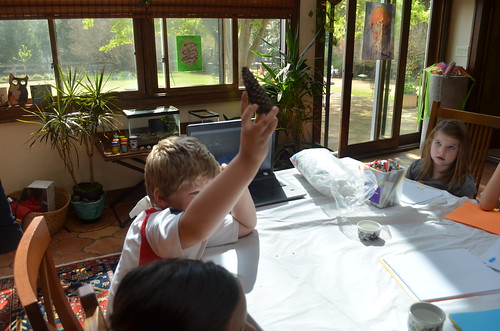
An hour later, many different models of the cone:
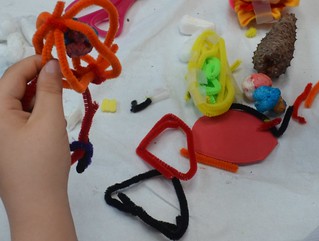
Serrin making tree-trunk as a 3D cylinder using orange 1-dimensional felt.
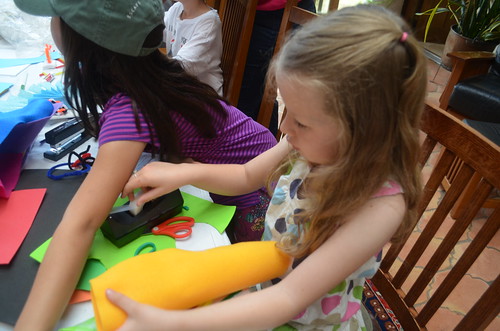
Cylinders are popular: here they serve as legs for a future doll:

Let’s make a cylinder out of ourselves. Or is it a circle? It’s both, kids say: depending on how you look at it.
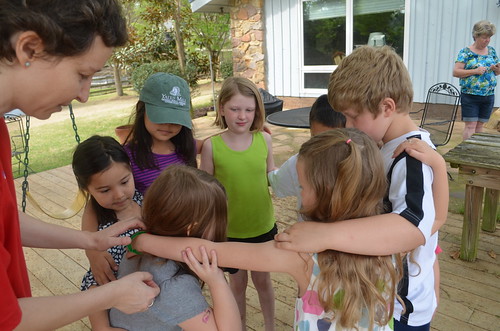
What kind of shape is this? Triangle? Half-circle?
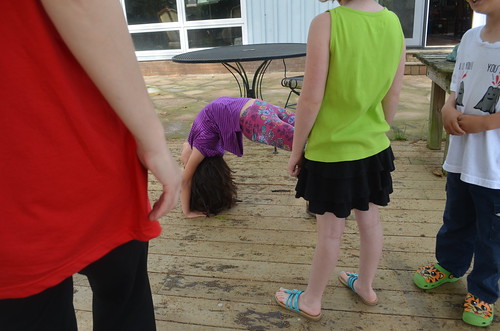
Maria pointing shapes she found in the backyard
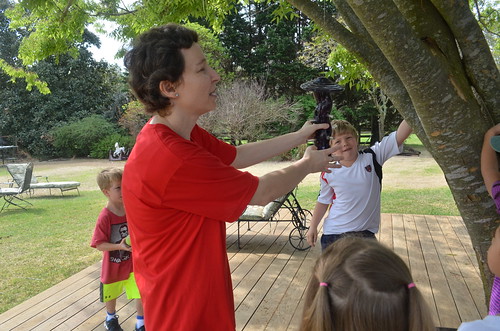
How do we make a square? Team building time. A square has 4 sides and 4 angles … “Let’s see, how many people do we have here? 1, 2, … 8. Okay, so a square has 4 sides if we divide by four that’s two people for each side.”
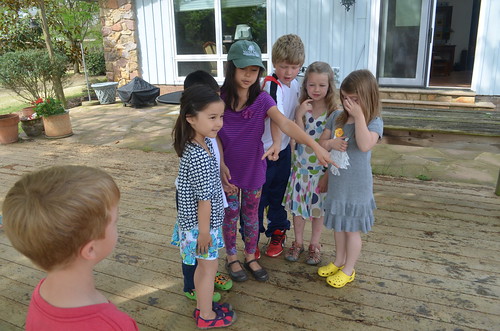
The group square is finally made! Smile!
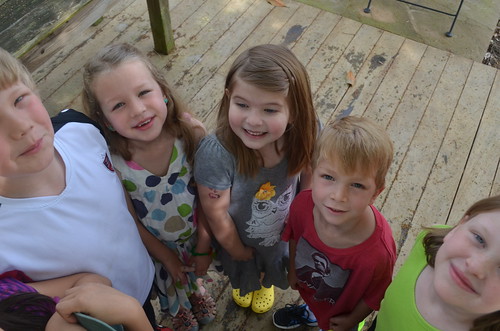
We found another shape! The table is made out of 2-dimensional glass circle! But it’s also a 3D cylinder, children say.
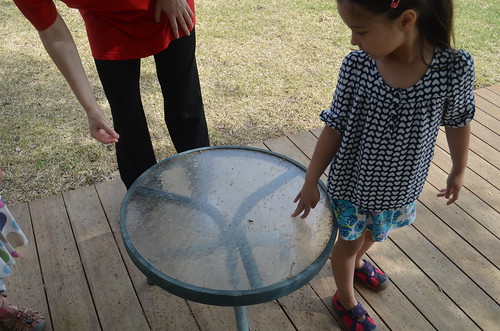
Here are the list of math words we collected from our creative craft makings on the board. Let’s see how the list growth from meeting to meeting.
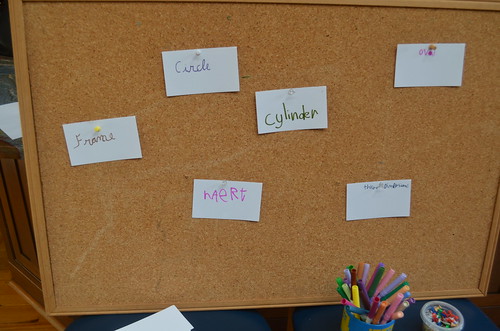
A snail and a 3-dimensional diamond shape Lego block.
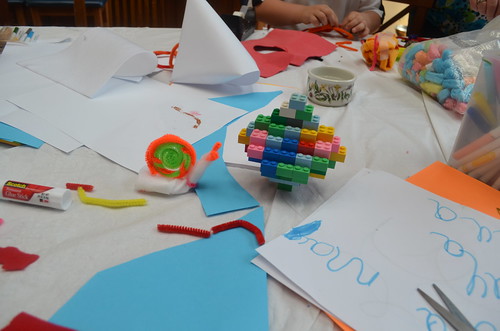
Making 3-dimensional pine cone with 1-dimensional pipe cleaners can’t possibly be this fun, right?
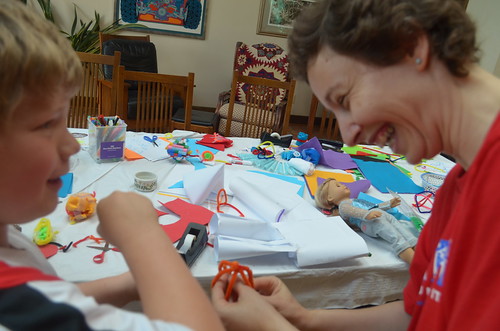
Snack time with mommy – and her 3-dimensional LEGO approximation of a… sphere!
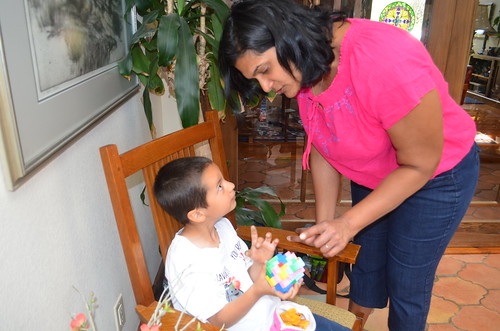
A colorful circular sphere out of rice-based packaging beans.
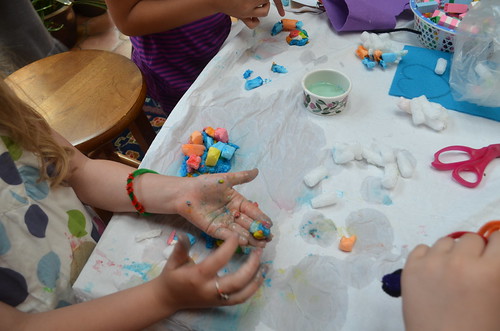
Made a line out of pieces using beans…
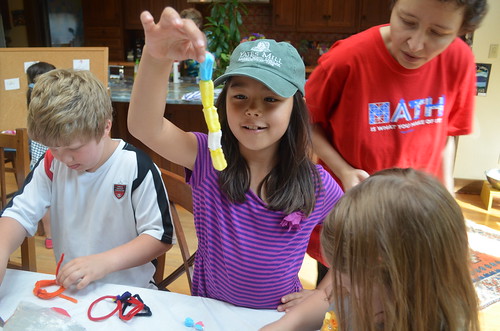
Turn a model into a scene (here, grass under a tree) for added interest – and added analysis. The three are discussing how connectors are used in different projects:

A spaceship among the stars. Another whole scene! Check out the lateral thrusters. “This spaceship does not need a nose cone, because it’s for deep space.”
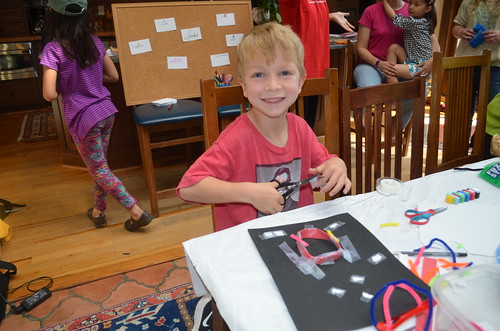
Photos by Erin Song, captions by Erin Song and Maria Droujkova, Math Spark by Kalid Azad, Shelley Nash, and Maria Droujkova.
Posted in Make
Calculus for Kids online – Monday! Filming your children’s reactions: Newsletter April 9, 2015
Subscribe and read archives
Pinterest | Twitter | YouTube | Facebook | Google+
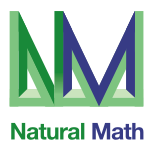
In this newsletter:
- Join us online: Calculus for Kids course for adults+children starts Monday April 13
- Spots in our Cary, NC circle starting Sunday April 12th in Cary, NC
- Join the Natural Math crew: film a reaction video and be a star
Calculus for Kids online course for adults+children starts Monday April 13
Join us for an intensive 4-week course for parents or teachers with their children ages ~5 and up. We designed the course with Shelley Nash, the organizer of Monarch Academy, a homeschool group that meets online and in physical space. The materials are created by Kalid Azad from Better Explained, an online project helping to grow math intuitions, and Maria Droujkova and Yelena McManaman of Natural Math.
This is the first time we offer such a course, so we will work very closely with every participant to learn what helps you best.
In this 6-minute talk from a festival, Maria Droujkova shares some of the big WHYs behind this project.

What do you get from Calculus for Kids?
- 4 weeks of mentoring from Maria! (Invaluable if you really want to “do math”)
- Each week you’ll have one live online class for the grown-ups, and one live online sharing session for grown-ups with kids.
- Sparks to get you thinking about math before the class.
- Resources after class to help you try out the Calculus activity with your children.
- Access to the Natural Math online forum to ask questions, even long after the class is over.
- Most importantly, you’ll get the confidence in your own ability to do math differently in your family!
Update: to get on the waiting list, email maria@naturalmath.com
Calculus for Kids math circle starting this Sunday in Cary, NC
We’ve never ran circles on Sundays before, but some people requested that day. Still, Sundays are less popular than weekdays, so we have a few spots left. Below is the information from the previous newsletter. Skip if you have already read it. But if you want to join us Sundays, starting April 12th, click here to sign up!
Here is a tiny sample of parent and teacher materials, called a Math Spark. We’ll have Sparks like that to go with every activity. The goal is to start thinking about ideas – to spark curiosity.
We will be running two math circles for children ages ~5-10 and their grown-ups in Cary, NC (conveniently close to Raleigh and Durham). The groups will meet on Sundays at 1 pm, starting April 12th and ending in May. These will be small mixed-age groups where children and adults come to have good times exploring mathematics together. Our Math Circles are for curious, inquiring, and playful families. Here is what participants get:
- Children: make calculus their own by making models, doing art, sharing ideas, and seeing the world from the new (calculus!) point of view.
- Parents: experience math as beautiful, useful, and fun; discuss ideas with peers; get a playful and fresh view on a key area of mathematics.
- Natural Math crew: play-test our upcoming book Calculus for Kids and prepare for an online course too (coming very soon – stay tuned).
We usually take shapes at face value, as a single entity. Calculus gives us superpowers to dig deeper! You don’t just see the tree. You know it’s made of rings, and that the rings are growing. Just imagine having X-Ray vision to use at will. That’s what our calculus is about!
Calculus for Kids is not just for children – it’s for parents and teachers too.
We will only have 8 children in each circle, so if you want to participate, sign up soon. If the space runs out by the time you try to register, email maria@naturalmath.com to get on the waiting list.
Update: the circle is full.
Join the Natural Math crew
We are growing. Join our adventures!
Video is one of the most requested things on Natural Math, but we haven’t done much of it. What videos do people want? Children doing Natural Math activities, and grown-ups showing what children’s actions mean.
One big change activities bring is that children “grow their math eyes” and start seeing mathematics everywhere. We want to capture that in a short reaction video. If you and your children want to be stars in our video, do this:
- Together with children, do a short activity about fractals and film it.
- Together with children, watch the video Cows&Cows&Cows (original or Minecraft version) and film reactions.
- Send us both videos.
We will give you more tips if you volunteer.
Here is a “kids react” video (not ours) so you have a sample of what we mean.
Email maria@naturalmath.com to join our video reaction project.
See you online!
Dr. Maria Droujkova and the Natural Math crew
Posted in Newsletter
Pi is calculus (for 5 year olds): Natural Math newsletter 3/14/15
Subscribe and read archives
Pinterest | Twitter | YouTube | Facebook | Google+

In this newsletter:
- Three awesome activities where Pi is calculus (for 5-year-olds) – happy 3/14/15
- March 27-28 MoSAIC: Mathematics of Science, Arts, Industry and Culture (Raleigh, NC)
- Work or volunteer for Natural Math
Celebrate Pi Day with calculus-inspired activities for the young and the young at heart
Happy 3/14/15 – and let’s hope you read it exactly at 9:26 for even more digits of Pi! Here are three activities for celebrating with your children and friends.
It’s a triangle! It’s a square! It’s a… circle?!
You will need a lot of straight thin objects about the same length: twigs you find outside, pencils on a blanket so they don’t roll, craft sticks, or simply strips of cut paper. Make a triangle out of your sticks. Add one more stick – you get a square. Add more sticks – you get a pentagon. Keep adding sticks. Pretty soon, you (better – your kids!) will marvel out loud that your shape is now a circle. Is it really a circle? Engineers say “Close enough!” and mathematicians say “No way!”

- Where is Pi? Do like the ancients. Measure the length of your stick, multiply by the number of sticks, and divide by the diameter of your circle (which you measure too). You get, and I quote the engineers, close enough to Pi – the ratio of the circumference to the diameter.
- Where is calculus? What you did here is approximating a curve with straight lines. This is a step in many calculus algorithms for integration, differentiation, and limits.
- A fun twist. Instead of sticks, use kids sitting on the floor, feet-to-behinds. It’s a great photo-op for a math circle – literally!
Three and a little bit
This is perfect for young children who are starting to fall in love with numbers: “Mom, what is a million?” Or those wishing to feel with their own hands where Pi comes from. You will need yarn, tape, or anything else you can easily unfurl and cut. Find a hula-hoop or a pot lid, or draw a large circle. Measure it across with your yarn and cut – that’s your unit (the diameter). Invite your child to estimate how many such units will fit around the circle.
Keep measuring out and adding units around your circle. Three should almost cover it, but not quite! Make an extra unit, and ask your child what part of it would fit into the space that is left around your circle. Will a half fit (fold your unit in half to show)? How about a third? Find a fraction small enough that it fits the gap. But if there is a bit more of the gap left, you can estimate that with a fraction of your fraction, and so on.
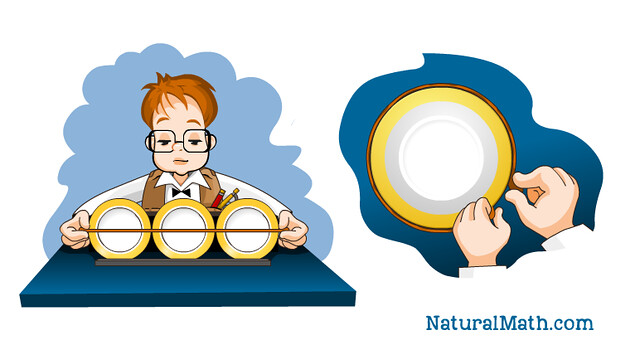
- Where is Pi? You are approximating Pi with diameter units. Start with three units, then add some piece of a unit (maybe 1/6 or 1/8), then add a smaller piece (maybe 1/4 of the piece you had before) and so on.
- Where is calculus? A mathematician claims that if you do your measurements very precisely, you will get an infinite series of fractions! Because Pi is irrational, your series will never end. Infinite series are a staple of calculus. But an engineer will say you’ll cover the circle completely in just a few steps, because your yarn measurements are approximate.
- A fun twist. With older kids, try dividing your unit (your diameter) into tenths, then those fractions into tenths, etc. You might see that the circumference is about three units, one tenth, and four hundredth… Pi = 3.14… but you may get slightly different values depending on your precision.
Pi=4
This is a teen or grown-up party trick. The steps are so simple a five-year-old would get them, but to enjoy the punchline, you do need to know what Pi is.
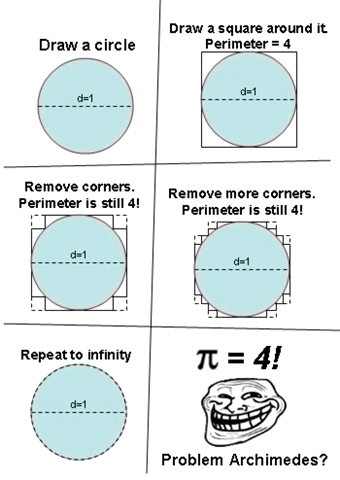
- Where is Pi? Well, we found Pi, and it’s apparently equal to four. Engineers like Archimedes who just approximate everything – beware! But wait, aren’t our previous two activities all about approximations? Were they all wrong too?! (No, they just happen to be okay.)
- Where is calculus? This intriguing piece of math trolling demonstrates that in the calculus world, things aren’t always what they seem. Taking a limit can easily go very wrong. Vi Hart has more to say. https://www.youtube.com/watch?v=D2xYjiL8yyE
- A fun twist. Could you use other shapes to “prove” Pi equal to other numbers?
For more young calculus, check out the Moebius Noodles collection!
MoSAIC Festival in Raleigh March 27-28
MoSAIC: Mathematics of Science, Arts, Industry and Culture is a festival celebrating the connections between mathematics and the arts. The festival will take place March 27-28, 2015 and it is free and open to the public. It is a great opportunity for children and adults to experience and reflect about the interplay between math and art, and for parents and teachers to find inspiration for student activities.

Join the Natural Math crew
We are growing. Join our adventures!
Part-time paid positions
- Lead math circles and courses. Help us meet the demand for family activities in the Raleigh-Durham, NC area, or lead online courses for families and teachers.
- Scout the web for young adventurous math. Want to seek young algebra and calculus around the web and blog about it? Want to look for innovative math circles and write their stories? This job is for someone who loves to browse the web, connect with interesting people online, and to blog.
Volunteer opportunities
Spend quality time with engaged people working on meaningful mathematics! You can volunteer as little as an hour per month. Our current volunteers include teens, parents, university researchers, software developers, retired professionals, social media activists, and creative writers. This is perfect for people who want more active but casual engagement, or want to ramp up their skillset and resume.
Email maria@naturalmath.com to talk about work or volunteering.
See you online! Dr. Maria Droujkova and the Natural Math crew
Posted in Newsletter
Math art collections: favorites on Pinterest
Here are three things we at Natural Math like to do with other people’s mathematical collections on Pinterest. Try for yourself if you have not yet.
- Browse a favorite collection, relax to beautiful images and videos, and meditate.
- Invite your children to browse together – it’s like a trip to an art museum, but it only takes 3 minutes and there is no driving.
- Take favorite pieces for your own collection. Here are our collections.
Our newest blog writer Ruby gives you a tour of five lovely math collections. Enjoy!
The board Pop up 3d by SO Satori features many great examples of pop-up artwork. Some of the designs are asymmnetrical in a way that makes you wonder how they created them. It makes you want to just grab a piece of paper and start folding!
The board Countable – 1 to 10 by Maria João Lagarto features various images that would be great to show to preschoolers to help them learn to count in a natural way. Some of the images could be used to teach multiplication or square roots.
The board Balloons_Math Related by Victoria Skye is a collection of photos and videos of amazing balloon art. It could be used as a cool and interactive way to teach kids about 3D models and fractals. No matter what, the amazing sculptures will capture your attention.
The board Mathy Math by Adelaide Leigh has great examples of radial symmetry and reflection symmetry art. Some of the pins include integration and fractals, while others are great ways to learn about modeling.
The board Reggio Classroom and Activities by Beck has lots of inviting activities for modeling with kids. Some of the activities use simple supplies like cardboard boxes. They are geared mainly towards kids that are 5 to 8 years of age.

Posted in Grow

